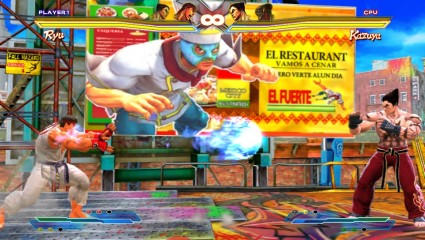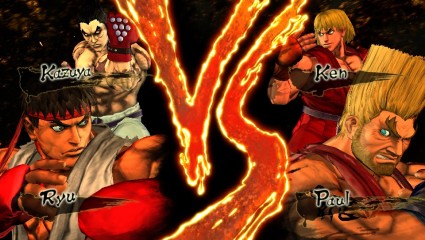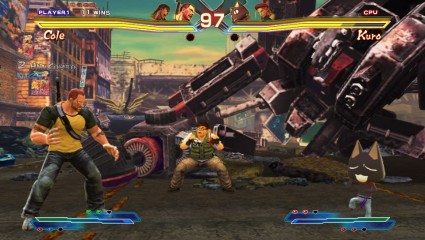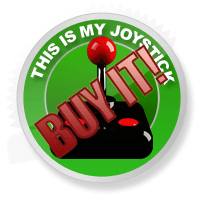Reviews
Street Fighter X Tekken (Vita)
October 31, 2012, Author: Andy Corrigan
Say what you like about the PS Vita, but it’s been a fantastic console for fighting game fans. BlazBlue, Ultimate Marvel vs. Capcom 3, and Mortal Kombat have been excellent additions to the system’s library, and hell, even Reality Fighters wasn’t completely awful when taken for what it was.
Now it’s Street Fighter X Tekken’s turn to bolster the Vita’s software library, and it doesn’t disappoint, not one bit…
Time to start penning your fan-fiction…
As with most fighting games, SFXT has a loose story to bring together the combatants of both worlds. A mysterious cube has fallen from the heavens and landed in Antarctica. It has been nicknamed ‘Pandora’ by scientists, as it seems to react heavily to nearby conflict.
It’s in good company then, as those from both the Street Fighter and Tekken franchises are known to enjoy a bit of conflict…
Tag, you’re it!
Thankfully, as someone who was desperate to click with Ultimate Marvel vs. Capcom 3 but never quite managed it, Street Fighter X Tekken takes most of its performance and handling cues from the Street Fighter series. At first glance it does perform and behave just as Super Street Fighter IV does, giving it this great sense of familiarity; however, there are also plenty of Tekken-oriented gameplay facets in there.
For example, both sets of fans will feel right at home with the controls. Street Fighter fans can still hammer away with their six-buttons, but by using the medium and high attacks, Tekken fans can unleash the combos they love in the way they’ve always been comfortable, without any need for tinkering in the options. Nice going Capcom.
The controls are exactly as you would hope; smooth and effortless with all major actions easily performed with the physical buttons. Capcom, however, have added in some customisable virtual buttons on the touchscreen and backpad, to aid throws and other such actions. I had limited success in mastering these, lacking the instinctive placement of my fingers and, because of that, I could never tell what I was actually pressing. Unsurprising then, that I gave up pretty quickly and stuck solely with the physical buttons.
Just like Namco’s Tekken Tag Tournament and Capcom’s other ‘Versus’ efforts, SFXT centres on a 2v2 tag system where the winning team is declared when one fighter’s health is completely depleted, or time runs out and one on-screen character has less health than the opposition.
Along with the standard Street Fighter setup of normal attacks and special moves, there are a number of other techniques that are at the player’s disposal to tip the tide of battle in their favour. The first one I’ll mention is the launcher, performed by hitting HP and HK simultaneously (standard character switching is performed by hitting MP and MK). If this lands, it knocks your opponent into the air before switching to your chosen partner, allowing you to run in with a fresh fighter and sneak a cheeky hit in.
Launchers can also be performed as part of a combo known as a Cross Rush. In a combo system not unlike UMvC3, by landing a combo that increases in strength (for example, LK, MK, then HK), the Launcher triggers automatically, allowing you to continue the combo started by the previous character.

The poster boys for their franchises face off…
As with nearly all fighting games these days, as you fight, you fill a bar at the bottom of the screen. Here it’s called the ‘Cross Gauge’ and is split into three sections. Street Fighter veterans will know how to use much of this already. When the bar is partly filled, you can use it to trigger an EX move, which is essentially a more powerful standard special move. When full, you can use it to perform a character’s Super Combo: the showy, automated attack that provides the fiery backgrounds when used as a finisher. SFXT has a couple of extra tricks here too.
When the Cross Gauge is full and you can successfully land a quarter-circle forward with both MP and MK, it’ll kick off what’s known as ‘Cross Arts’. This starts the current character’s Super Combo, before knocking the opponent backwards into your other fighter to finish the job. These look spectacular in motion. By landing a backwards quarter-circle and both medium attack buttons, it’ll activate Cross Assault, which sees your tag-partner on-screen alongside you as you both pummel the living crap out of your foe. Messy, yes, but great fun.
A risky attack, best used only as a desperate measure, is ‘Pandora’. Pandora can only be activated with a full Cross Gauge and when you’ve got less than 25% of your current character’s health. When activated (by tapping down twice and hitting both medium attacks), the move sacrifices your on-screen character, but bestows huge strength and an unlimited cross gauge to their tag partner. The downside is that Pandora only has a short window for usage, and if you fail to bring your opponent down in that period, you’ll lose the fight by default. Perfect for occasions when it’s all or nothing.
Then there’s the Gem system, which has drawn a little negativity from some quarters, but it’s hard to deny that they open the playing field slightly between newcomers and veterans. There are two main kinds of gem that can be assigned to characters: Boost Gems and Assist Gems. When they get activated from meeting certain conditions during the fight, they can affect your fighters in various ways.
Boost Gems will directly affect your fighter’s attributes, so you could use a gem that slashes the damage you take, or lower the amount of Cross Gauge you need to perform Super Combos and Cross Arts. Assist Gems are more passive and help to make parts of combat that bit easier. For example, you could simplify the controls so that a Hadouken only requires a down and forward motion, rather than the quarter circle, or you could have one that blocks automatically or auto-escapes throws. You have to be careful, though, because these particular Gems will eat away at your Cross Gauge during usage.
In reality, the gems don’t tend to affect the fight as much people might fear. They actually add another level of strategy, allowing you to set up your gems to account for your weaknesses, or just to compliment how you play the game.
There are a whopping 55 characters on offer in this Vita version, including all the DLC and PS3 exclusive fighters from the off, and although I’ve not extensively used every single one of them (although I have used them all at least a handful of times), I’ve certainly had no issues with regards to balancing. It’s hard not to be impressed at how Capcom have woven in each of the Tekken roster too. Regardless of their fighting style, the Tekken fighters manage to keep all of their signature moves in the transition to a 2D plane; yet, somehow, they all feel as if they’ve been in Street Fighter since the very beginning. That’s a huge testament to Capcom’s work here.
Of course, there are a few options to keep you occupied outside of the Arcade mode. There’s Burst Kumite, which is essentially the single-player equivalent of the Endless Battle mode, seeing you trying to chain together as many wins as possible. Mission mode has you trying to win fights under certain conditions, such as only using certain moves or using no special moves at all. Trials are all about learning each character’s repertoire over 20 individual challenges, and I found this to be the most useful mode, really helping you hone those skills.
On face value, SFXT does seem lighter in modes than its peers, but just like Street Fighter IV before it, it’s the strength of the fight mechanics that will keep people playing over and over again. The best news is that this handheld port is almost indistinguishable from the home console version, making it one of the most polished, fully-featured portable fighters I’ve ever had the privilege to play.

White vs. Red…
Bulging biceps…
Some other fighting games, most notably Mortal Kombat, had to take a visible graphical hit on Vita. While Capcom managed to mostly avoid that with UMvC3, they’ve made a much better fist of it in Street Fighter X Tekken. The game runs as smooth as hell, and I’ve yet to see any visual hiccups, looking utterly stylish with its bright and colourful design.
It was only the backgrounds in UMvC3 that ever let the game down, as nit-picky as it is to say; environments that were fully animated in other releases became eerily static in the portable version. That’s far from a problem in SFXT, as each arena tells its own progressive story over every 2-3 rounds you fight in. You’ll see Jack and a Robotic Zangief interacting in space on the outside the space station stage; Tekken’s Sumo fighter Ganryu getting himself into trouble in a steel mill; and boxing Dinosaur, Alex, getting too big for his boots while taking on two T-Rexes in the Dino Crisis inspired level. It’s fan service incarnate.
Are you Ken?!
SFXT is an audible treat on every level, as it perfectly mirrors its bigger brothers. From the pumping soundtrack that helps you get your game face on, to the cries and shouts of the fighters as they perform their signature moves, it’s an authentic arcade experience.
It’s also full of minor, but very pleasing attention to detail. My favourite being that all the characters speak in their native tongues, rather than having the choice between an American vocal set and a Japanese vocal set. It just feels right in this context.
World warriors…
In terms of online functionality, SFXT is probably the strongest game the Vita has ever seen, entirely matching its home console counterparts. Not only do you have the usual array of modes, but the game is completely cross-compatible with the PS3 version. So when you jump online, you might not only be doing battle against fellow Vita players, but also PS3 players too. Wholly impressive, and it instantly opens up the number of fights available to you.
In terms of modes, the game is missing something as substantial as the Heroes & Heralds mode of UMvC3, but there is enough to be getting on with online. Ranked fights and Endless battles are a given in Capcom games now, but it also includes Scramble mode, a 2v2 mode where all four players occupy the screen at once. Like the Cross Assault move in standard matches, it can be messy, but it’s not without its charms. The online package is nicely rounded off with the excellent Replay Channel and Replay Analyser, allowing you to watch fights back, see where you went wrong, and check out how the best players approach their fights.

The PS3-exclusive characters are in from the start…
You win!
The strength of Capcom’s fighters, for me, has always been in their excellent flow and the amount of strategy that’s possible because of it. Every fight is different, tense and finely balanced, and Street Fighter X Tekken too encapsulates that, even on Vita. Capcom’s crowning achievement, however, isn’t just in creating an able fighter; they’ve been doing that for years. It’s also in the way they’ve flawlessly woven in Tekken’s roster and quirks without compromising their own beliefs. Combining the two franchises has resulted in an undeniably exhilarating package, one that’s now available portably.
Judging by their efforts in the last two years, Capcom really do have that knack of developing and porting the highest quality to the handheld market. Street Fighter X Tekken is easily their best effort yet in this field, going to lengths that other handheld developers just aren’t going to, especially online. Frankly, they’re showing everyone else up with such highly-polished, handheld efforts like this.
Put simply, it’s the finest portable fighter that money can buy.
Platforms: PS Vita | Tagged Akuma, Bison, Fighters, Fighting games, Kazuya, Ogre, pandora, Paul, Ryu, Street Fighter, Tekken, Tekken Tag Tournament, Vita



